
Guests
- Chris Hondrosstaff photographer for the international photo agency Getty Images. Note: Images courtesy of Chris Hondros/Getty Images.
Links
We speak with Pulitzer Prize-nominated photojournalist Chris Hondros. He is best known for graphic photographs he took in the northwestern Iraqi city of Tal Afar in 2005 when U.S. troops opened fire on a family of eight approaching a checkpoint in a car. Both parents were killed while the six children in the backseat looked on. [includes rush transcript]
Transcript
JUAN GONZALEZ: We end today’s broadcast with Pulitzer Prize-nominated photojournalist Chris Hondros. He has worked in most of the world’s major conflict zones since the late 1990s, including Kosovo, Angola, Sierra Leone, Afghanistan, Kashmir, the West Bank, Iraq, Lebanon and Liberia. Chris’s work has appeared on the covers of major magazines and on the front pages of most American newspapers.
AMY GOODMAN: Chris is a staff photographer for the international photo agency Getty Images. He’s just returned from his ninth stint in Iraq, which he chronicled at his blog, gettyimages.com, joining us in our firehouse studio.
Chris, you are well known for this remarkable series of photographs in Tal Afar. Can you explain what happened?
CHRIS HONDROS: Yes. It was a couple of years ago now. It was in January 2005, and I was embedded with U.S. Army troops in Tal Afar in northern Iraq. I’d been sent there by the Army. I had wanted to go to Mosul, where there were some battles going on at the time, but I’d been sort of waylaid to go to Tal Afar, because you don’t always get the embeds that you want in Iraq. And I was with a group of soldiers on a routine evening patrol around dusk, about 6:00 or so, right around the time where the curfew was held in Tal Afar, and a car on the darkened streets sort of appeared in the distance and started coming down the boulevard toward the soldiers. As is well known, you know, the soldiers don’t like cars coming towards them. They fear suicide bombers and things. They weren’t sure what to do. They fired a few shots. The car kept coming, and so they shot up the car. And tragically, an Iraqi family was in the car, parents and six children, and the parents were killed instantly. And I documented that event.
AMY GOODMAN: And then the children that came out of this car.
CHRIS HONDROS: Well, you know, the children — one of the children — I mean, the children were, of course, terrified and covered in — blood had splattered in the car, and they were covered in blood. The soldiers realized the mistake immediately and rushed up, took the children out. They weren’t sure who was injured, who was not, and they sort of evaluated the children on the sidewalk, in front there. I photographed all that. And one of the children, it turned out, had a gunshot wound, as well, and they were all transported to the local hospital and dropped off there.
JUAN GONZALEZ: A really powerful image it is, especially of one little girl with blood spattered all over her. Did the soldiers at all try to prevent you from taking any of those photos?
CHRIS HONDROS: No, they didn’t, really. I mean, they were sort of in the moment, as so often happens in these situations, you know. Everybody was in the moment and doing their things, and I was photographing just sort of discreetly there what was going on. And they never tried to stop me in any way at the time.
AMY GOODMAN: Describe the little girl, this most famous image of the little girl next to a soldier’s boots and weapon.
CHRIS HONDROS: Yeah. Her name, as it turns out, is Samar, Samar Hassan, and she was five years old at the time of the picture. And, you know, the soldiers — there weren’t that many soldiers. It was just part of a platoon, maybe five or six, one medic for the whole thing. So the medic was one by one trying to evaluate the children to see what sort of injuries they might have had, and Samar was there just crying, you know, while one of the other children was being attended to. And she’s standing next to the soldier. I think one of the reasons the photo had this sort of resonance that it does is because it has a sort of empty feeling: you know, the poor girl, all alone in the world now, just standing there in the dark, you know.
JUAN GONZALEZ: What’s been the impact on your ability to continue to do embedded work with other troops? Not had any problems since then?
CHRIS HONDROS: No, not really. I mean, I’ve never been embedded again with this particular unit.
AMY GOODMAN: Did you have to leave after you took these pictures?
CHRIS HONDROS: Yes, I did. You know, because — I think, from a practical standpoint, I mean, whenever you’re embedded in Iraq, you know, there is this sort of a relationship that’s there, and after an incident like this happens, I think it’s impractical to continue being embedded with that same particular group of soldiers. It’s just a tragic thing all the way around, and it’s just not going to work out after that.
But since then, I’ve been embedded all over the country, as well. And, in fact, General Petraeus gave a speech to a media group recently, and he cited these series of photos as a good example of press-military relations in Iraq, because he said that, “Look, this incident happened, but, you know, the sort of the facts were clearly presented, and, you know, when I give interviews talking about it, I talked about this, the reality of the mistake, and so on.” And so, you know, from his perspective, when tragic things happen as long as they’re fairly presented, they don’t have a problem with it. So I’ve never had a problem there.
AMY GOODMAN: There are two new provisions in the news media ground rules for joining an embed by the Pentagon that arguably further limit press freedom. It says media will not be prohibited from covering casualties, provided the following conditions are adhered to: Names, video, identifiable written, oral descriptions, or identifiable photographs of wounded servicemembers will not be released without the servicemember’s prior consent. That means if you photograph a wounded soldier, and you don’t have access to him, unless you have his consent or her consent, you can’t show it.
CHRIS HONDROS: Written consent of a soldier on a gurney or something. You know, I mean, these things are handled — in practice in Iraq, these things are handled under the commander of the unit that you happen to be with. I mean, there’s long been the sort of embed rules and a sort of a contract that you sign whenever you do an embed. In practice, they’re either — the rules you operate on in an embed are either more restrictive or less, just depending on the local commander. I mean, it’s a large organization, the U.S. military, and it has a lot less central control sometimes than we think.
AMY GOODMAN: Can you be unembedded in Iraq?
CHRIS HONDROS: Can you operate as a journalist, unembedded?
AMY GOODMAN: Yes.
CHRIS HONDROS: With difficulty. I mean, you could still in Iraq go, say, to somebody, quietly go to somebody’s home, for instance. If you set up an appointment, you can maybe interview somebody if they come to your protected hotel. Journalists are doing that right now. There is still unembedded reporting happening in Iraq. But I would say that embedded reporting is an enormous piece of the pie, and it’s a very important part of journalists covering Iraq right now.
JUAN GONZALEZ: And has it become increasingly difficult? I mean, you’ve been there eight times now. How would you judge the change in the situation? Has it been improving at all?
CHRIS HONDROS: In regards to embedding, or broadly speaking?
JUAN GONZALEZ: Broadly speaking, in terms of your ability to do your job.
CHRIS HONDROS: Of course, every trip back has been worse and worse, really.
AMY GOODMAN: Chris Hondros, we’re going to have to leave it there. I thank you very much for being with us. The photographs will be at our website at democracynow.org. Chris Hondros, Pulitzer Prize- nominated photojournalist, thanks for joining us.

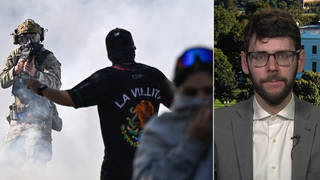
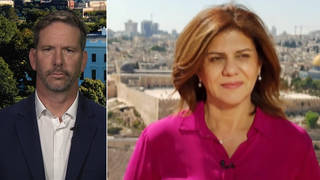
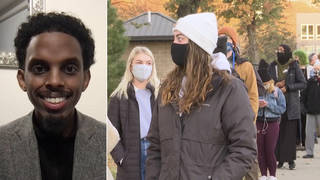
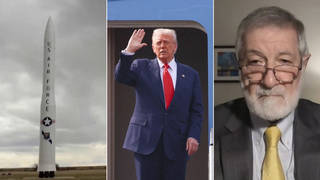





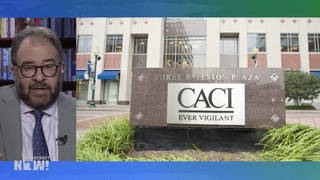

Media Options